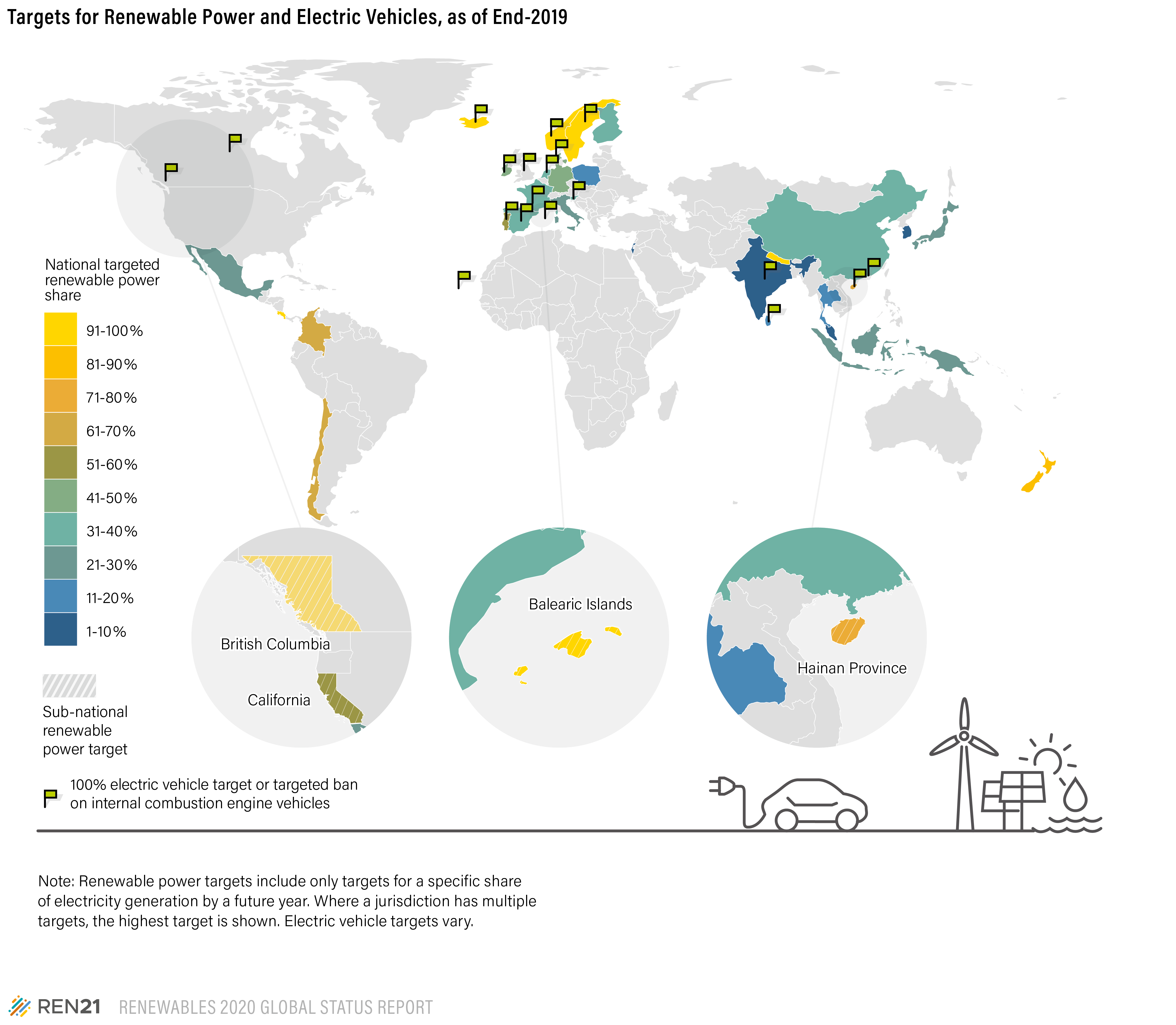1 July 2020 In Blog Post, Climate Change, COVID-19, Dialogue and Networking, Energy, Global, Sustainable Development
How can the transport sector build back better from the COVID-19 crisis and what is the role of renewable energy in this recovery?
Rana Adib, Executive Director, REN21
COVID-19 has woken us up. Our economies have completely locked down, and transport has decreased significantly. This has led to reductions in carbon dioxide emissions and air pollution and has given us a glimpse of how life could be if we were able to make the necessary shift to a low-carbon economy. However, the relief is only temporary, and even locking down our economies for a decade would not allow us to reach goals set in the Paris Agreement.
Burning fossil fuels is a key contributor to climate change, and the transport sector is a major consumer of these polluting fuels. The transport and energy sectors are interlinked. To decarbonise our economy the transport and energy sectors, therefore, need to align their strategies. These sectors must work together to make the radical shift needed to phase out fossil fuels, address climate change and ensure the health of citizens.
We need to avoid transport when possible and shift mobility to zero- and low-emissions modes. We also need to make a system-wide switch to renewable fuels, like renewable electricity, sustainable biofuels and renewables-based electro-fuels.
But we have a long way to go to shift to a renewables-based transport system: globally, transport accounts for 32% of the total final energy demand, and energy demand in the transport sector is increasing faster than in any other sector. Meanwhile, it is the sector with the lowest share of renewable energy. Renewables only contribute 3%.
COVID-19 and ensuing lockdowns have created a major disruption in the transport sector. The money now earmarked for transport in various recovery bills needs to be used to create an opportunity for a highly fossil-fuel dependent sector to reinvent itself. We have an opportunity to build on the momentum of a global decrease in transport activity. This means, for example, moving to active mobility like walking and cycling, using more efficient mobility like electric mobility, but also enlarging toward a systemic ‘from well to wheel’ approach to achieve a low-carbon sector. We must avoid the temptation of low oil prices to return to ‘business as usual.’ We need strong government leadership to avoid locking us into fossil fuel-based investments, infrastructures and economic activities that will be around for decades.
So what could governments do?
A holistic Avoid-Shift-Improve framework should guide governments’ actions. To strengthen the development of renewables in transport, governments must develop sectoral targets and strategic plans that tightly link transport and energy. Here’s what governments can do:
Reinforce the link between the electrification of transport and the use of renewable power.
The electrification of transport, whether in rail or road, is not only a possibility to increase efficiency. It also creates the possibility to use renewable power, which is not only low-carbon, but also more cost-efficient and resilient compared to fossil fuel-based power. To date, many countries with electric vehicles (EVs) targets have very low targeted renewable power shares or their EVs are not powered by renewables and this will not change unless they revise their renewable power targets.

Provide incentives for electric vehicles.
Despite some advances, the market share of EVs remains very low – electric cars still only comprise 0.6% of passenger vehicles. To encourage change, governments can use fiscal and financial incentives to increase electric vehicle uptake and mandate that the power used in these vehicles comes from renewables-generated power. Vehicles that use sustainable biofuels should also be encouraged.
Build necessary infrastructure.
Charging stations, refueling stations and public transport services need to be developed to decarbonise transport. Integrated infrastructure planning for intercity and high-speed rail, zero-emissions logistics and last-mile delivery, need to be designed and should be powered by renewable energy. In terms of integrated planning, public utility commissions in regulated power markets can enact policies that target energy utilities. Specifically, pricing structures and time of use rates can encourage charging at times when the supply of variable renewable energy (VRE) is highest.
Support sustainable biofuels.
Globally, biofuels (liquid and gaseous) are growing. However, reduced oil prices means that biofuel producers will need financial support in order to meet existing targets and policies. Increased financial support for sustainable biofuels as well as fiscal and financial incentives to increase vehicles that use sustainable biofuels should be included in any rescue and recovery package. But there must be conditions: financial support should have specific environmental criteria, encouraging only sustainable biofuel.
Put a meaningful price on carbon.
The true cost of burning carbon needs to be reflected in fuel prices. We also need to put a meaningful price on carbon emissions. A carbon tax will level the playing field so that low-carbon energy sources like renewables can flourish to their full potential
Ban the use of fossil fuel in transport and phase out fossil fuel subsidies that distort the market.
In order to fully level the playing field for renewable energy, governments need to take an offensive position and stop using fossil fuels. This means phasing out fossil fuel subsidies, divesting from fossil fuels and implementing fossil fuel bans. Already, fourteen countries have targets to ban fossil fuel vehicles – more leaders should follow suit.
Support the (further) development of technical solutions for transport sectors that are more difficult to decarbonise, like aviation, shipping and long-haul heavy transport. Technological solutions such as electro-fuels exist, but further R&D, pilot-projects, supported market development are needed and can lead to needed cost reductions.
- Reinforce the link between the electrification of transport and the use of renewable power. The electrification of transport, whether in rail or road, is not only a possibility to increase efficiency. It also creates the possibility to use renewable power, which is not only low-carbon, but also more cost-efficient and resilient compared to fossil fuel-based power. To date, many countries with electric vehicles (EVs) targets have very low targeted renewable power shares or their EVs are not powered by renewables and this will not change unless they revise their renewable power targets.

- Provide incentives for electric vehicles. Despite some advances, the market share of EVs remains very low – electric cars still only comprise 0.6% of passenger vehicles. To encourage change, governments can use fiscal and financial incentives to increase electric vehicle uptake and mandate that the power used in these vehicles comes from renewables-generated power. Vehicles that use sustainable biofuels should also be encouraged.
- Build necessary infrastructure. Charging stations, refueling stations and public transport services need to be developed to decarbonise transport. Integrated infrastructure planning for intercity and high-speed rail, zero-emissions logistics and last-mile delivery, need to be designed and should be powered by renewable energy. In terms of integrated planning, public utility commissions in regulated power markets can enact policies that target energy utilities. Specifically, pricing structures and time of use rates can encourage charging at times when the supply of variable renewable energy (VRE) is highest.
- Support sustainable biofuels. Globally, biofuels (liquid and gaseous) are growing. However, reduced oil prices means that biofuel producers will need financial support in order to meet existing targets and policies. Increased financial support for sustainable biofuels as well as fiscal and financial incentives to increase vehicles that use sustainable biofuels should be included in any rescue and recovery package. But there must be conditions: financial support should have specific environmental criteria, encouraging only sustainable biofuel.
- Put a meaningful price on carbon. The true cost of burning carbon needs to be reflected in fuel prices. We also need to put a meaningful price on carbon emissions. A carbon tax will level the playing field so that low-carbon energy sources like renewables can flourish to their full potential.
- Ban the use of fossil fuel in transport and phase out fossil fuel subsidies that distort the market. In order to fully level the playing field for renewable energy, governments need to take an offensive position and stop using fossil fuels. This means phasing out fossil fuel subsidies, divesting from fossil fuels and implementing fossil fuel bans. Already, fourteen countries have targets to ban fossil fuel vehicles – more leaders should follow suit.
- Support the (further) development of technical solutions for transport sectors that are more difficult to decarbonise, like aviation, shipping and long-haul heavy transport. Technological solutions such as electro-fuels exist, but further R&D, pilot-projects, supported market development are needed and can lead to needed cost reductions.

Rana Adib

Rana Adib
Rana Adib is the Executive Director of REN21 a global public-private multi-stakeholder network on renewable energy. Previously, Rana was REN21’s Research Coordinator developing the international expert community and leading the REN21 Renewables Global Status Report series to become an international reference. Rana has also worked in private industry and applied research in the areas of renewable energy, energy access, and waste management. She was also responsible for coordinating the biogas-to-energy research programme of Veolia Environment. Rana holds a Master’s Degree in industrial engineering from the University of Wedel in Germany. She has over 20 years’ experience in the energy sector.